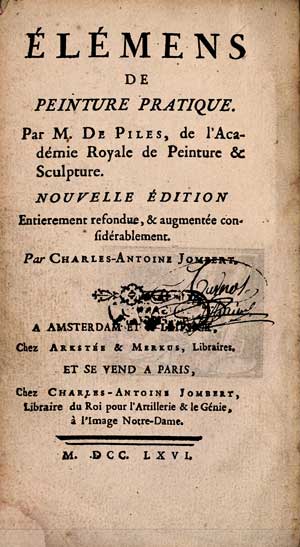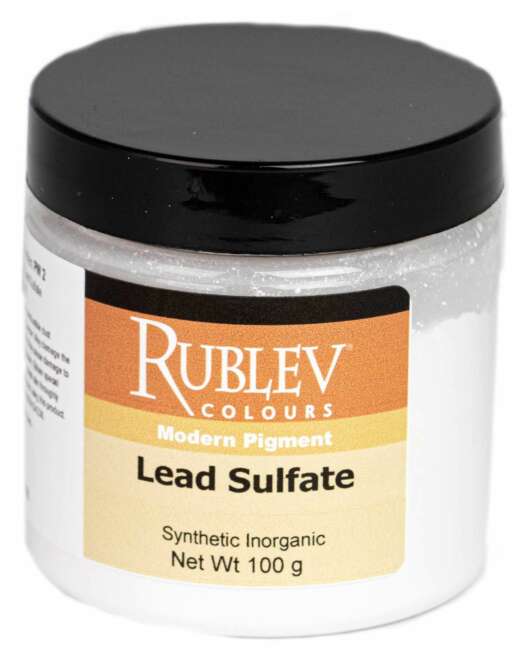
 The palette described by Roger de Piles in his seventeenth-century painting manual, Les Elémens de Peinture Pratique, describes a pigment in French, brun rouge (brown red). The primary palette described by de Piles comprises these colors:
The palette described by Roger de Piles in his seventeenth-century painting manual, Les Elémens de Peinture Pratique, describes a pigment in French, brun rouge (brown red). The primary palette described by de Piles comprises these colors:
1. White lead. 2. Yellow ocher. 3. Brown red. 4. Lake. 5. Stil de grain. 6. Green earth. 7. Umber. 8. Bone or ivory black.
My interest is to provide hues that closely resemble the colors found on this seventeenth-century palette, but not only the hues, the undertones, and the paint consistency. It is relatively easy to mimic a hue with a combination of pigments, but much more difficult to the undertones and nearly impossible its consistency in paint. The latter can only be done successfully by using the same pigment, at least as far as we can determine from literary sources.
Natural Pigments makes lead white, several yellow ochers, green earths, numbers, and a bone black as pigments and oil colors, but I was unsure about the hues and tones meant by the term brun rouge (brown-red) and Stil de grain. I understand what is meant by these names, but there are a large number of possible variations with these pigments.
 I began my research with the name brun rouge and attempted to find what this name represented in the seventeenth century when de Piles wrote his treatise. In reviewing the literature on pigments and painting treatises, it appears that the term Brun rouge used by de Piles is used interchangeably with rouge Anglais and rouge d'Angleterre, and light red, burnt ocher, and brown red. De Piles assigns brun rouge to the category of natural iron oxide earth pigments:
I began my research with the name brun rouge and attempted to find what this name represented in the seventeenth century when de Piles wrote his treatise. In reviewing the literature on pigments and painting treatises, it appears that the term Brun rouge used by de Piles is used interchangeably with rouge Anglais and rouge d'Angleterre, and light red, burnt ocher, and brown red. De Piles assigns brun rouge to the category of natural iron oxide earth pigments:
L'ocre ou brun rouge; c'est une terre naturelle, ainsi que les couleurs suivantes. L'ocre jaune est de même nature: elle devient rouge quand on la brûle; au contraire l'ocre rouge devient jaune: pour les calciner, on les met au feu dans une boîte de fer. Il en est de même de l'ocre de rut, qui fait un jaune obscur; c'est une espece de limon qui se trouve dans les ruisseaux des mines de fer; lorsqu'elle est calcine, elle prend une fort belle couleur. (de Piles, 190)
Ocher or brown red is a natural earth, like the following colors. Yellow ocher is of the same nature: it turns red when it is burnt; whereas yellow ocher turns red: to calcine it is put in the fire inside an iron box. Likewise for ocher of rut, which makes a dark yellow; it is a kind of silt that can be found in the streams of iron mines; when it is calcined, it takes a gorgeous color.
As an aside, it is interesting that in one instance he recommends the addition of driers to brun rouge used in priming the canvas:
On imprime ensuite la toile avec quelque couleur simple & amie des autres couleurs, comme du brun rouge broyé à l'huile, médiocrement épais, dans lequel on met quelque siccatif, qui est pour l'ordinaire un peu de mine rouge ou de blanc de plomb bien broyé, pour le faire plutôt sécher. (de Piles, 127)
Then prime the canvas with some simple color compatible with other colors, like brown red ground in oil, hardly thick, in which there is some drier, that is red lead or white lead ground well, to make it dry faster.
Many sources agree on the nature of the pigment brown red, as Thorpe describes:
Light red, Burnt ochre, Brun rouge, also, is calcined yellow ochre. The period of heating is 10 hours. This pigment is an opaque, permanent, and innocuous colour, of a scarlet tint, tempered by shades of brown and grey. (Thorpe, 274)
Church adds to this description of the pigment:
Light red possesses a considerable degree of opacity. Its hue may be defined as scarlet, modified by a little yellow and grey. It is perfectly permanent and without action upon other pigments. (Church, 179)
Others have described the hue and undertone of brun rouge as that between Indian red, which has cold purplish undertones, and red ocher with warm undertones. A nineteenth-century author, Laughton Osborn, recounts the use of brun rouge as given by the French painter Bouvier:
It is found native; but is obtained also by calcining the ochre or ochres, No. 5. A very vigorous color, it must be employed discreetly, for its intensity increases in oil, and its energy makes it easily overpower its allies. Therefore, do not employ it in any clear and bright part, especially not in the lights of carnations, nor even in the lighter shadows. Reserve it for all your dark and vigorous shades and touches, particularly those of the nostrils and of the mouth (adding thereto a great deal of deep crimson lake), as well as for the strongest shadows, mixed with Roman Ochre and intense Ultramarine, with a third of the best blue-black to finish the flesh.
It is good for many other cases, too long to enumerate, as in draperies of a dusky red or brown, and even in the shadows of bright-red drapery, adding in sometimes Vermilion, sometimes Madder-Lake, according to circumstances. This detail will be further extended when we come to treat of the First-Palette orDeadcoloring, and also of finishing. (Osborn, 16–17)
Osborn identifies No. 5 as brown ocher or Roman ocher, which he describes as a dark yellow.
Later it appears the term brun rouge was applied to an artificial iron oxide color, as indicated by the following passage in a 19th century book:
For English red or colcothar:
Colcothar is also produced by the wet way, in mixing a solution of sulphate of iron with another of carbonate or, better still, bicarbonate of soda. There is formed a soluble sulphate of soda, and a precipitate of carbonate of protoxide of iron, which is soon transformed into hydrated sesquioxide of iron. This is washed, dried, and calcined at a red heat in clay crucibles. It is said that, when the precipitation is effected in hot liquors, the colcothar is finer, more velvety, and deeper in color. (Riffault, 424)
The name red-brown was applied in the 19th century to an iron-lead oxide mixture as the same author continues:
Red-brown is quite a handsome reddish substance, very durable, but little used. It is obtained by fusing in a clay crucible, 1 part of red oxide of iron and 10 parts of litharge or red lead, which have been thoroughly mixed. After cooling, the mixture is ground. (Riffault, 426)
The conclusion from a review of the literature reveals that in the 17th-century brun rouge or brown red was a natural iron oxide earth pigment, such as red ocher, that had scarlet half-tints (undertones) subdued with brown and gray that was found naturally as such or calcined from dark yellow ocher. Among the extensive list of earth pigments available from Natural Pigments that could fit that description, Venetian red is a good match for brun rouge.
Rublev Colours Venetian Red is a good fit for brun rouge on the 17th-century palette.Shop Now for Venetian Red Oil Paint |
Sources
Arthur Herbert Church. The chemistry of paints and painting. Seeley and Co., Limited, 1901.
Laughton Osborn, Pierre Louis Bouvier. Handbook of young artists and amateurs in oilpainting: being chiefly a condensed compilation from the celebrated manual of Bouvier, with additional matter selected from the labors of Merimée, de Mmontabert and other distinguished continental writers in the art in seven parts. John Wiley, 1849.
Jean René Denis Riffault des Hêtres, Armand Denis Vergnaud, G. Alvar Toussaint, François Malepeyre. A practical treatise on the manufacture of colors for painting: comprising the origin, definition, and classification of colors; the treatment of the raw materials etc. Translated by A. A. Fesquet. H.C. Baird, 1874.
Thomas Edward Thorpe. A Dictionary of applied chemistry. Vol. 4. Longmans, Green and Co., 1913.
Acknowledgment
I want to thank Paul Rhoades, Francisco Benitez, and Anne Marcy-Benitez for their suggestions regarding my English translation of Roger de Piles' text.










